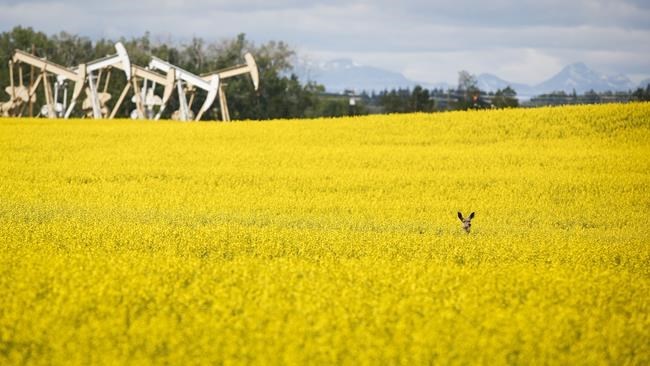TORONTO — Farmers like Andre Harpe have a little extra spring in their steps these days as agriculture crops fetch their highest prices in years, joining a boom in commodities such as lumber and base metals that is good news for the Canadian economy.
"Life is never perfect but I think it is a good time to be a farmer," 56-year-old Harpe said during a break from seeding his 5,000-acre farm in Alberta's Peace Region.
The canola and malt barley farmer says canola prices have about doubled from a year ago.
Growing demand as the global economy recovers from the COVID-19 pandemic, coupled with supply shortages from droughts in some areas of the world, have created the chance for Canadian farmers to earn more money in a cyclical industry.
Depending on the crop, agriculture prices have increased between 10 and 75 per cent from last year, says Brandan Leslie, manager of policy and government relations for the Grain Growers of Canada.
"On the heels of a decade of fairly flat to downward prices it's pretty good news for Canadian farmers," he said in an interview, pointing to the threat of drought this summer in Western Canada and the U.S. Midwest.
"Until it's achieved and the grain is in the bin, the high prices don't mean much but certainly a real opportunity I would say for future profitability for farmers."
Prices started to increase about 12 to 18 months ago, then underwent a big jump in 2021.
Canola recently hit a 13-year peak after stubbornly low prices, gaining 52 per cent year-to-date. Corn has surged 50 per cent in the past four months to reach its highest level since 2012, soybean prices are returning to levels not seen since 2013-2014 and wheat prices are the best since 2012.
"All of the benchmark crop prices are back to the highest they've been since that very severe drought that they had in the Midwest back in 2011-2012," said Aaron Goertzen, senior economist for the Bank of Montreal.
The current price environment comes after five or six years of strong overall growing conditions that produced solid harvests but low prices that created stress, especially for U.S. farmers.
The low Canadian dollar helped to offset some of the pressure on domestic farmers.
Many commodities prices collapsed at the start of the pandemic but crops performed better than oil and metals since people still needed to eat, even when manufacturing was at a standstill.
The big exception was corn, which was affected by reduced fuel consumption because of its use to produce ethanol that's mixed with gasoline. Prices for the corn-based fuel derivative are up 63 per cent in 2021, mirroring a recovery in gas prices.
China is always a driver of commodity demand but the world's second-largest economy has taken a renewed interest in feeder crops after purchases were hurt when about 30 per cent of its hog herd was culled in response to a mass outbreak of African swine fever starting in 2018.
China has significantly increased its purchases of U.S. soybeans since a boycott during trade tensions under former president Donald Trump. China is the biggest consumer of soybeans, accounting for about 60 per cent of global sales.
"As that herd is now coming back, China's increasingly buying feed products on global markets and of course now with the trade war also over, it's buying them also from the U.S. and so that's been supportive of pricing as well," said Goertzen.
Strong prices allow farmers to invest more on infrastructure and equipment to improve output, said Brian Innes, executive director of Soy Canada.
"We're seeing right now a lot more optimism for farmers who are in their fields right now planting this year's crop," he said from Ottawa.
Strong prices allow farmers like Harpe to invest in new equipment and technology that's going to help the economy and create spinoff employment.
He's seeding an extra 100 acres of land that weren't previously in production to take advantage of the higher prices, and says others are doing the same.
High commodity prices are positive for Canada's economy, stock market and the loonie, says Avery Shenfeld, chief economist at CIBC.
Even though oil prices aren't high by historic standards, North American benchmark West Texas intermediate is up 32 per cent so far in 2021, while other key exports such as lumber and forest products and some metals are particularly strong.
"We're getting more Canadian dollars for each tonne of lumber or grain and that creates more income in the country that helps power our recovery," he said.
Lumber prices are up 85 per cent in 2021 on robust U.S. housing construction and renovations. Copper is up 34 per cent, iron ore 45 per cent, steel 40 per cent, aluminum 24 per cent, lithium 91 per cent, cobalt 39 per cent and tin 45 per cent.
"We're an exporter of raw materials, a 'hewer of wood and drawer of water' as they historically have said, so it's a plus for Canada when we're getting more for those commodities."
The downside of higher commodity prices is its contribution to inflation — a particularly worrying concern for stock markets — some of which will show up in food prices as extra costs are passed along to consumers.
Economists expect commodity prices will cool off over the next year, not because the global economy will have slowed but because producers who have underinvested in the last few years will have time to address supply disruptions and crank up production.
Ultimately, even elevated crop prices may not mean much to farmers who can't control their biggest threat: Mother Nature.
"Huge parts of Western Canada are pretty dry right now," said Harpe, a third-generation farmer. "Just because prices are good, we still need to get an average crop to realize those prices."
This report by The Canadian Press was first published May 16, 2021.
Ross Marowits, The Canadian Press



